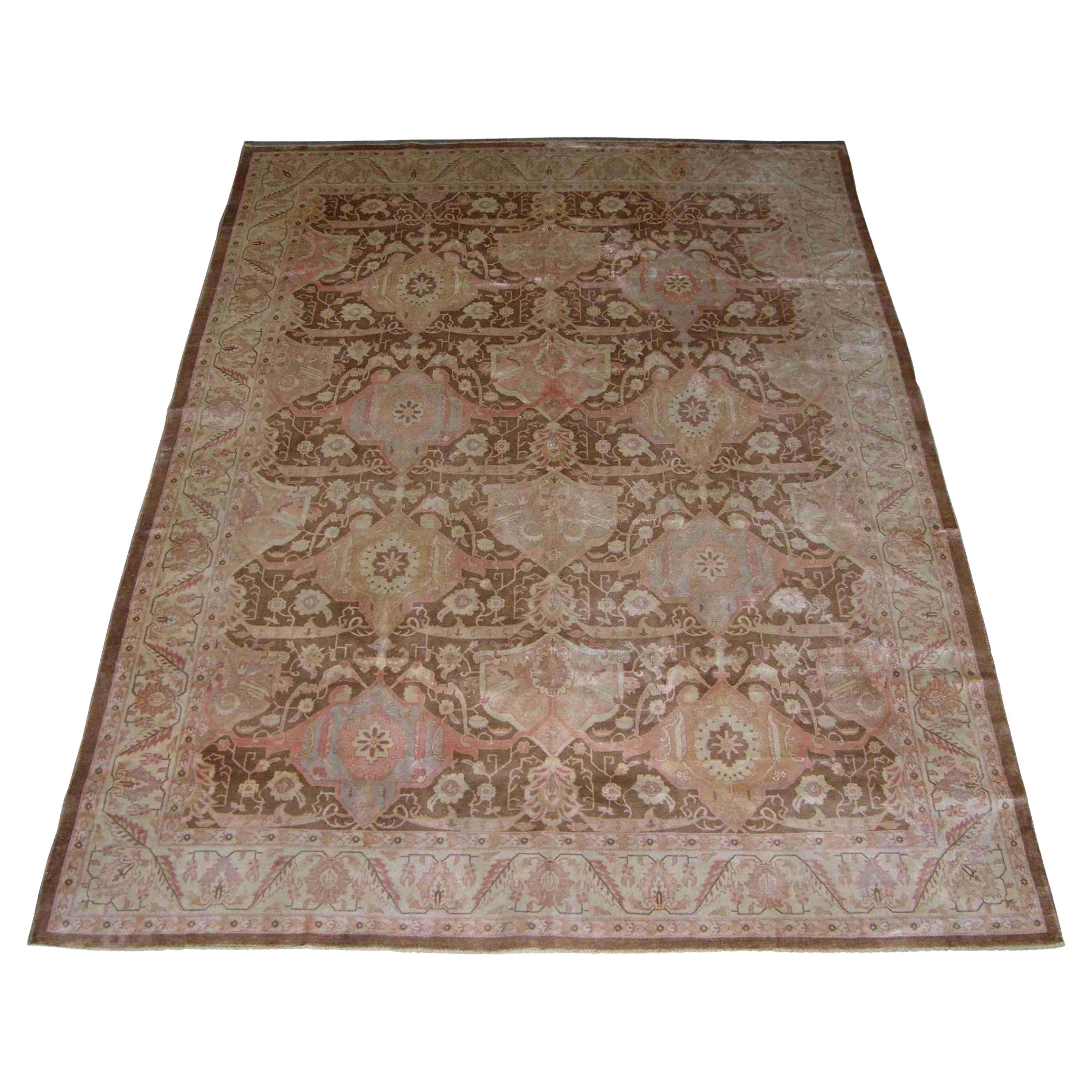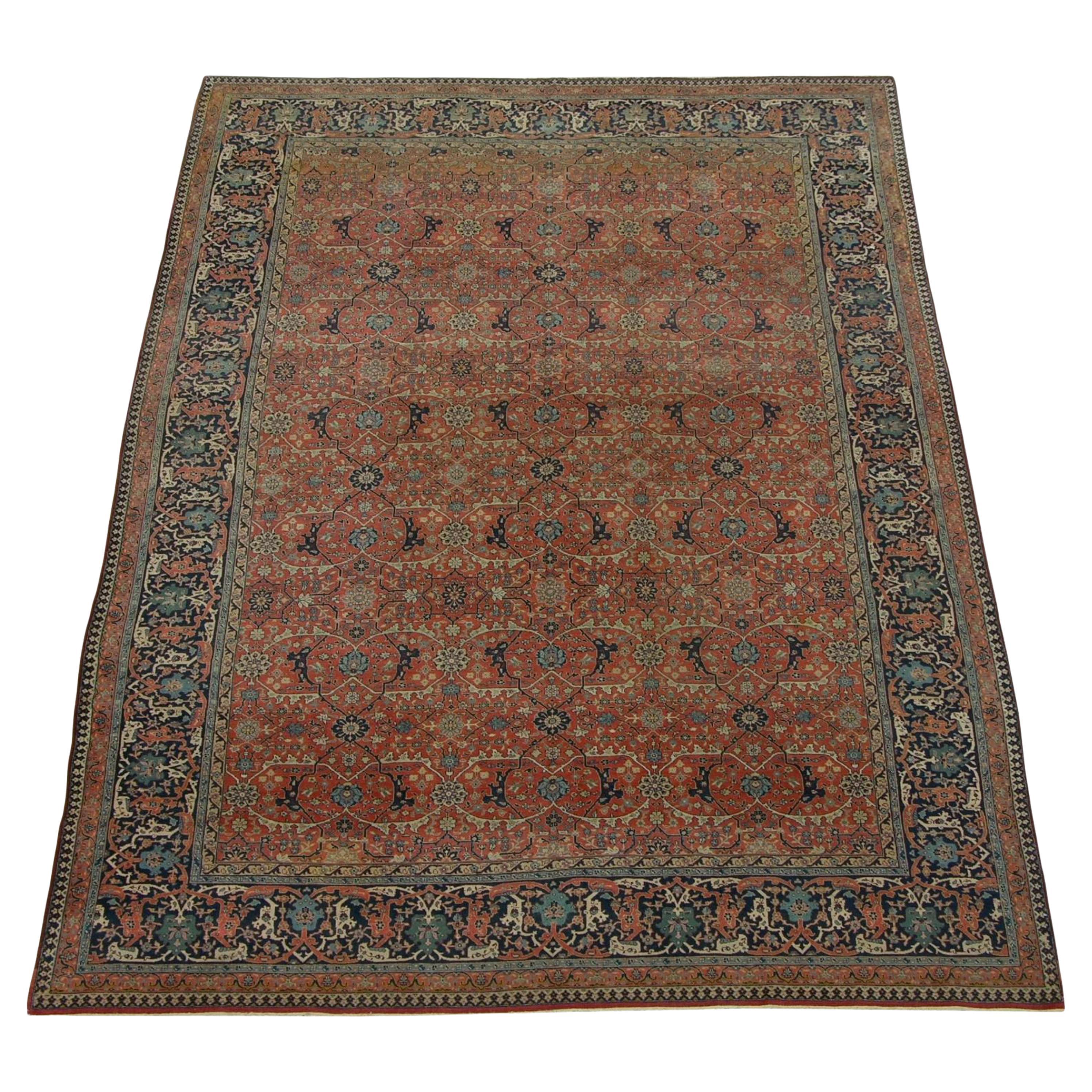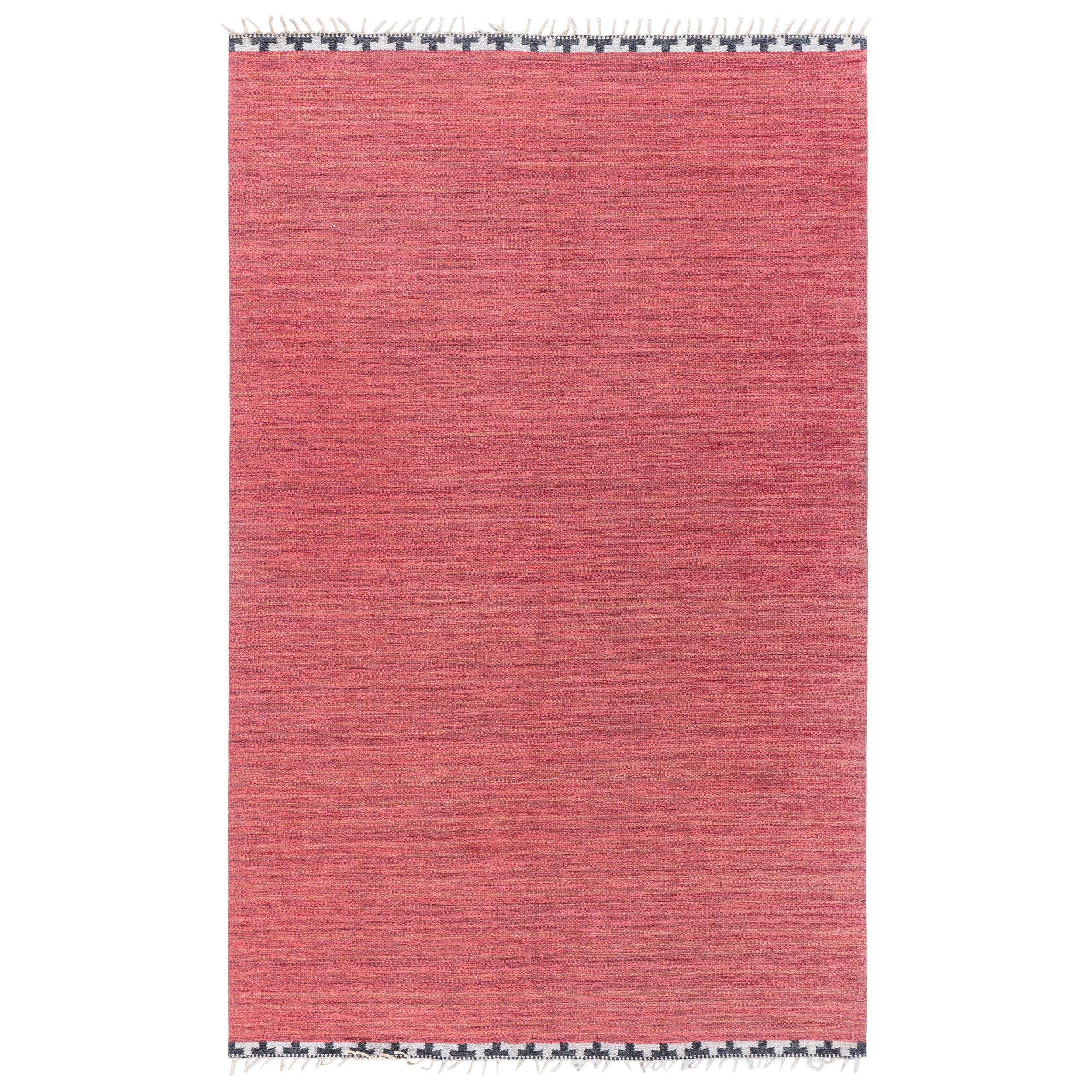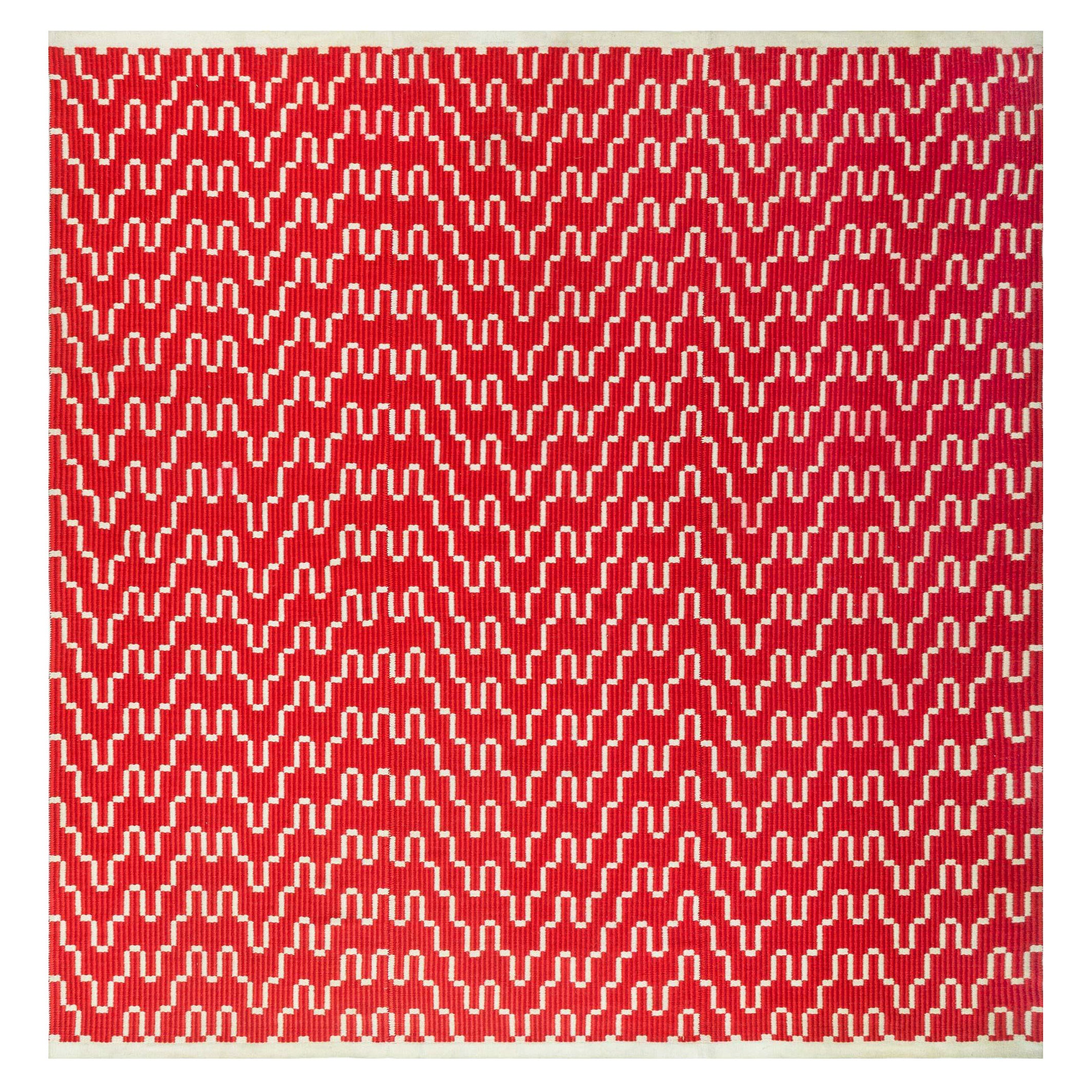Want more images or videos?
Request additional images or videos from the seller
1 of 5
Vintage Red Tabriz Rug
About the Item
Antique Tabriz rugs are distinguished by their excellent weave and by their remarkable adherence to the classical traditions of antique Persian rug design. But they cannot be distinguished by any particular pattern or by their coloration. The city of Tabriz, in northwest Iran / Persia , was the earliest capital of the Safavid dynasty, and it can claim to have been a center of carpet production longer than any other city in Iran. Consequently, it is not surprising that the carpets woven there have been able to preserve the highest technical standards and the most varied repertoire. Antique Tabriz rugs offer classical medallion designs and a host of allover patterns as well in every color imaginable, from brilliant rich tones to soft pastels. What sets them apart from other Persian rugs is their quality.
Tabriz is the capital of Azerbaijan, a province in the north of Iran. It has survived repeated destruction by numerous earthquakes and invasions by the Mongols, Tamerlane, Ottomans and Afghans, as well as two Russian occupations. During the late 19th century three Persian master-weavers, Haji Jalili, Sheik Safi and Kurban Dai contributed to Tabriz’s revival and Tabriz rug merchants began exporting Persian antique rugs to Western markets on a large scale. There is no traditional color scheme and the variety of color is limitless, ranging from rich jewel tones to subtle pastels. Tabriz rugs are precisely drawn and executed with care making them extremely popular among designers.
Traditionally, Tabriz has been a city of master weavers. The ateliers in this influential carpet-weaving city established a strong reputation for classicism and quality that is still respected today. Regional carpets feature effortless curve-linear designs, Safavid emblems, allover Herati (fish) patterns, spectacular medallions and masterful motifs of all shapes and sizes.
Antique Tabriz rugs have been sought after by rug aficionados for decades. They are not only one of the finest groups of Persian rugs to have been produced in Persia, they are also extremely decorative as well. The rugs of Tabriz are among the most beautiful and most desirable of antique Persian rugs, and have been manufactured in the Azeri speaking area of Northern Iran continuously for centuries.
There are few things in this fine world that say true chic status. Sure, everyone has champagne wishes and caviar dreams. I mean I know I, personally, wake up everyone morning and take a bath in Dom Perignon.
All that being said, when you aren’t jet setting to St. Bart’s for the weekend or going yachting on the Mediterranean, you are spending some hefty time in that luxurious pile of bricks you made home for yourself. What better way to deck out your pad than with a piece of beauteous history with our featured rug, Antique Tabriz rugs.
Nazmiyal Antique Rugs has been at the precipice of bringing the elite and socially-savvy home accents that screams, “I rule the world!” The Tabriz rug adds a sense of elegance to any abode it calls home. Tabriz rugs are some of the world’s best kept secrets in the world of antiquities and high-life social orders.
These puppies are known for the insurmountable quality, detail-oriented weave, and historical background. For centuries, Tabriz rugs have been made with the utmost quality since their inception where Tabriz, located in norther Iran, was one of the earliest capital of the rug world. They boast bragging rights since they are the oldest in terms of production in all of Iran.
Tabriz Persian carpets and their beauty do not only rely upon their rich cultural background, but their design is a force that is untouched by any rug in the industry. Coming an array of colors under our prismatic spectrum, the Tabriz rug may be found in any color whether you’re looking for bold designs and palettes or something softer with lush pastels. Their design elements are bold and full of character work of medallions, floral motifs, or picturesque patterns.
Nothing sets the Tabriz apart from the rest of home accents than their true quality of prestige. So, if you really want to evoke the feeling of running the modern-day world with these antique pieces, get yourself a Tabriz rug. We promise your guests will be envious and enraptured in all the Tabriz rug has to offer.
- Dimensions:Width: 72 in (182.88 cm)Length: 105 in (266.7 cm)
- Style:Other (In the Style Of)
- Materials and Techniques:
- Period:
- Date of Manufacture:1960
- Condition:vintage Condition.
- Seller Location:Los Angeles, US
- Reference Number:
About the Seller
5.0
Gold Seller
These expertly vetted sellers are highly rated and consistently exceed customer expectations.
Established in 1920
1stDibs seller since 2023
27 sales on 1stDibs
Typical response time: <1 hour
- ShippingRetrieving quote...Ships From: Los Angeles, US
- Return PolicyA return for this item may be initiated within 3 days of delivery.
More From This SellerView All
- 1940s Vintage Tabriz RugLocated in Los Angeles, USLocated in the far northwest of Persia, Tabriz has been a leading center for the production of the finest rugs and carpets since the fourteenth century if not earlier. By 1500 it had...Category
Vintage 1940s Other Russian and Scandinavian Rugs
MaterialsWool, Cotton
- Antique Tabriz Rug Floral DesignLocated in Los Angeles, USAntique Tabriz rugs are distinguished by their excellent weave and by their remarkable adherence to the classical traditions of antique Persian rug design. But they cannot be disting...Category
Antique Early 1900s Asian Other Russian and Scandinavian Rugs
MaterialsWool, Cotton
- 1900 Vintage Khotan Samarkand RugLocated in Los Angeles, USAntique Samarkand Rugs: The desert oasis of Khotan was an important stop on the Silk Road. The people of Khotan were expert carpet weavers who produced high quality antique rugs and ...Category
Antique Early 1900s Other Russian and Scandinavian Rugs
MaterialsWool, Cotton
- Vintage Central Asian Style Samarkand RugLocated in Los Angeles, USAntique Samarkand Rugs: The desert oasis of Khotan was an important stop on the Silk Road. The people of Khotan were expert carpet weavers who produced high quality antique rugs and ...Category
Antique Early 1900s Other Russian and Scandinavian Rugs
MaterialsWool, Cotton
- 19th Century Vintage Samarkand RugLocated in Los Angeles, USAntique Samarkand Rugs: The desert oasis of Khotan was an important stop on the Silk Road. The people of Khotan were expert carpet weavers who produced high quality antique rugs and ...Category
Antique 19th Century Other Russian and Scandinavian Rugs
MaterialsWool, Cotton
- 1950s Vintage Floral Design Needlepoint RugLocated in Los Angeles, USAncient Roots Of Needlepoint Rugs Archaeologists and scholars consider the roots of needlepoint to have been around 1500 BC. They consider the first needlepoint to include the fine diagonal stitches that were used to sew tents together by the ancient Egyptians. The art eventually evolved into tapestry weaving. However, a tapestry weaving differs significantly from needlepoint in that it uses a loom and vertical warp. Tapestry weaving is closer to the weaving of kilims and pile rugs than canvas work. However, some still include tapestry weaving in the category of needlepoint because of the fine work that appeared during the late Renaissance. It can have a similar appearance to the untrained eye. Technically, tapestry weaving and needlepoint are not the same, and they do not use the same technique. The first actual needlepoint rugs and needle-points began to appear in the late Renaissance. Needlepoint is worked by creating stitches on a stiff canvas. The canvas is typically made from jute or linen and is quite durable. Pieces from the Renaissance were used to cover footstools, chairs, pillows, bed headboards, and other furnishings. They were also used as table coverings and wall coverings. You could also find them on many small items such as purses, shoes, and various adornments for clothing. During the Renaissance, the craft reached a high level of skill, and the designs became incredibly detailed and realistic. They mimicked many of the subjects and styles of famous paintings of the time. They created florals, still life designs, scenes, and geometric tiled pieces. Some of them mimicked the designs found in Persian Carpets. Needlepoint reached its peak popularity in the 19th century when it was considered a proper occupation for a lady. Needlepoint and embroidery held a similar place in societal status at the time. During this time, the work became finer, with some of the canvas reaching a high level of detail. The level of detail is determined by counting the number of mesh in an inch. During this time petit point by French needlewomen could have a mesh count as high as 45 mesh. This allowed women to create highly intricate designs with incredible levels of detail. Historical Needlepoint Carpets and Rugs It is possible to find many antique pieces of needlepoint besides rugs. Needlepoint rugs were popular in France and Spain, where the technique was adapted to create highly intricate designs that mimicked the designs in architecture and fashion. They were popular because they were durable, and it could be fashioned into a variety of items. The canvases themselves were durable, and the wool that they used was also strong, which means that many of the pieces were able to withstand daily use. We have many artifacts that have survived from this time period. Needlepoint rugs are important collectibles because they are different from the pile rugs and kilims that are typically found on the market. Needlepoint carpets are special because they take many hours to create, especially larger works. Needlepoint pieces of any type became popular throughout Europe during the 19th century. It is still a popular hobby today, but perhaps one of the most interesting stories is that of the Portuguese needlewomen of Arraiolos. The story of these women and their beautiful carpets begins in 1492. Needlepoint was a popular occupation in Spain, which had a large population of Moors and Jews. They were an integral part of Spanish culture. However, in 1492, Queen Isabella of Spain issued a proclamation that gave these ethnic groups the order to pack their bags and board ships headed...Category
Vintage 1950s Other Russian and Scandinavian Rugs
MaterialsWool
You May Also Like
- Vintage Swedish Red Flat Woven RugLocated in New York, NYVintage Swedish red flat woven rug. Size: 6'4" × 10'0" (193 × 304 cm) A Mid-20th Century vintage Swedish flat woven wool rug. The main field of this vintage Swedish rug is left plain...Category
Mid-20th Century Scandinavian Mid-Century Modern Russian and Scandinavia...
MaterialsWool
- Antique Russian Area Rug Tabriz DesignLocated in Dallas, TXAntique Russian area rug handwoven from the finest sheep’s wool. It’s colored with all-natural vegetable dyes that are safe for humans and pets. It’s a traditional Tabriz design hand...Category
20th Century Russian Tabriz Russian and Scandinavian Rugs
MaterialsWool
- Vintage Abstract Rug with Bold Red ColorsLocated in New York, NYThis very high pile, coarse weave carpet show a borderless, abstract pattern roughly resembling a floral design writ very large, in warm shades of tangerine, orange-red, red and dar...Category
Late 20th Century Danish Russian and Scandinavian Rugs
MaterialsWool
- Vintage Red Flat Woven Double Sided RugLocated in New York, NYVintage flat woven double sided red rug Size: 9'8" × 10'3" (294 × 312 cm) A vintage double sided, flat weave wool rug dating back to circa 1960. The main field features an all over d...Category
Mid-20th Century Scandinavian Mid-Century Modern Russian and Scandinavia...
MaterialsWool
- Ivory Light Blue Red Vintage Caucasian Shirvan RugLocated in New York, NYVintage decorative Shirvan rug woven in the villages and mountains of the Caucasus with blue and red accents on a clear white ivory color ground. Measures: 3'7" x 5'2" The desi...Category
20th Century Caucasian Kazak Caucasian Rugs
MaterialsWool
- Hand Knotted Antique Rug Red Blue Floral Pattern Wool Russian Rug by Rug & KilimLocated in Long Island City, NYOriginating from Russia circa 1890-1900, this antique piece connotes a Karabagh rug with a colorful approach to florals in deep, saturated hues arranged geometrically for clean arrangement. A favorite of our principal Josh Nazmiyal, the weave and design indicates Armenian characteristics lending to its collectability in equal measure to its unique use of color. This traditional style features a black background on which sit roses in pink, yellow, blue, red, and green with leaves of a bright red. Three borders appear on this antique Russian rug...Category
Antique 1890s Russian Other Russian and Scandinavian Rugs
MaterialsWool





